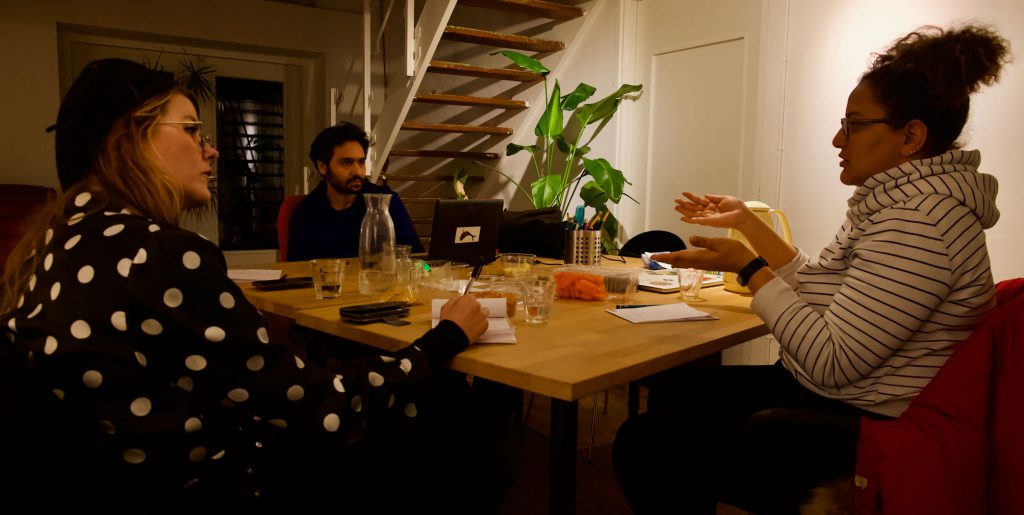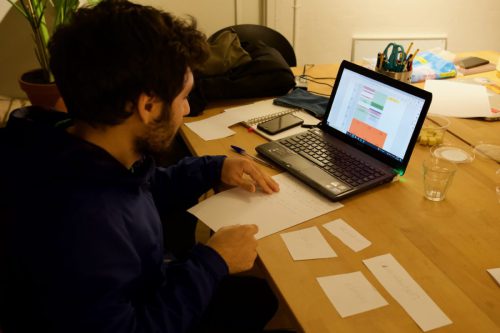The Amsterdam Lab formed part of Between Death & Birth, the December moment in DOTE’s year of listening.
Participating Artists:
Dina Mohamed, Bethany Crawford, Wael Kadlo, Fariborz Karimi, Samantha McCulloch
Death, is a topic more than often avoided and feared in our day-to-day lives. However, some cultures carry a different relation and perspective on death. In the Tibetan culture, the acceptance and preparation for death is seen as an integral part of the journey of life. The Tibetan philosophy of death emphasizes the importance of understanding the impermanence of all things and using the contemplation of death as a tool for personal growth and spiritual development. This approach offers a unique perspective on the meaning and value of our time on earth, and can provide a sense of peace and acceptance in the face of death.
“On the more spiritual level, however, Tibetans have learned to view the ordinary fearsome death as a strong force close to life, a powerful impulse to the good. An intensifier of positive attitudes and actions. They tend not to get caught in reification of death as a force of pure evil, some sort of radical, insensate, arbitrary malevolence. They rather learn to see it as non-existent as a thing in itself apart from life. This sense of the relationality of even death encourages them to view death on the highest level as the immediate, omnipresent realm of freedom, not merely part of life but the ground of life.”
The previous passage from the “Great Book of Natural Liberation Through Understanding in the Between” or as known to some “The Tibetan Book of the Dead”, describes the inspiration for a two-session lab in Amsterdam where five artists gathered to discuss and reflect on death. In the light of the Tibetan philosophy, the sessions were our way to explore the possibility of preparing oneself for their own death and the death of others.
How do we prepare for our own death?
The conversation started with the simple question of how much do we think about death, and if we think that we are prepared to face it or not. The group began by sharing personal experiences and beliefs surrounding death, and discussing the fear associated with death and the impact of proximity to death on one’s relationship to life.
“Hey! now when the dream between dawns upon me,
I will give up corps-like sleeping in delusion,
And mindfully enter unwavering the experience of reality.
Conscious of dreaming, I will enjoy the changes as clear light.
Not sleeping mindlessly like an animal,
I will cherish the practice merging sleep and realization.
(The root Verse of the six betweens, page 115)
To gain a different perception and imagination on death, we searched for inspiration from different cultural practices around death.
Ideas and questions from the Toraja culture:
Torajans, an ethnic group from South Sulawesi, Indonesia, view funerals as major celebrations. The family of the deceased can spend months, or even years, preparing for the funeral. During this period, the body of the deceased remains in the home and is cared for by the family, who continue to bring food and change clothes. Then comes the Ma’nene Day. A sort of a festive day where families dig up the remains of their deceased relatives and spend the day with them. This unique ritual led the group to ponder about the impact of this proximity to death and dead bodies on the relationship with death and life. It raises the question if living with the dead bodies for an extended period is a form of normalization with death or an extended denial of it.
During the Ma’nene Day celebration, we watched the families laughing and playing with the remains of their ancestors, talking to them and carrying them around in a joyful manner.
We looked as well at the Famadihar celebrations in Madagascar, where we saw how the bodies of the deceased were handled with joy and dance. These happy scenes steered the conversation toward the notion of honouring the dead and their memory by celebrating the living.
In the second part of our session, we wanted to dig more into our ways of dealing with the death of others. We looked for different expressions of loss, grief and also fear. How humans create different methods to deal with death.
Christian medieval chants: Dies irae
Traditional funeral group chanting form upper Egypt (3adeed)
Trojan male circle chanting
It is easy to notice that practices surrounding death vary from place to place, but there are underlying similarities that can offer some wisdom. What caught our group was the collective sound or breathing and how it can serve as a form of sharing, connecting and releasing emotions of grief. Also, the role of music and rhythm, alongside the power of words or just sound, in creating waves of vibrations that travel through the collective bodies to heal and mend the grieving hearts.
The second session we turned to the concept and imagination around the notion of eternity, and immortality, epically the digital immortality.
What does eternity mean? Or the eternal? Would you want to live forever?
How would you want to live forever?
Bethany Crawford brought excerpts from Ernest Becker’s “The Denial of Death” and Zygmunt Bauman. “Mortality, immortality and other Life Strategies” to address these questions. The conversation explored the longing for immortality as the underlying force for building civilizations, and the challenge that drive human to create legacies.
Outcomes:
The outcome of the sessions came in various forms, but it can be understood in the light of the Tibetan five tools of preparation for death.
The outcome of the sessions were presented in different formats of poems performance, spells and performative readings within “Between Death & Birth Amsterdam”. At the same time, echoes and traces of the works were presented in “Between Death & Birth Cairo” and vice versa.
The outcomes can be understood in the light of the Tibetan five tools of preparation for death.
1) Informational:
How much do we know about the process of death, specifically about what happens to the body and in what order the changes occur? It raises the question about the impact of modern practices such as outsourcing the care of deceased loved ones to professionals on individuals’ preparation for death. Did that change the way people prepare for death and the understanding about the process of death?
Bethany Crawford’s work came in the form of poems. Poems that take close look at death as an embodied experience.
The poems were performed in “Between Death & Birth Amsterdam” by Agnes Matthews
My eyes are swollen with exhaustion
All I do is work
Staring at symbols on my screen
Already a life that is in the between
Of both death and living
An organismic stasis
So please take my eyes
So I can see
Through the belly of the worm
That eats me
And chomp my nose sweet maggot friend
So I may smell in pleasure your digestive blend
Of earth, and juices, and guts and parts
Finally I might live across distributed hearts
of many animals, critters, bugs and bits
When my composed body goes to shit
dismantles and breaks
my enzymes unregulated
catabolise, anabolize, metabolitated
as a banquet for the many
My touch expanded, once my fingers, then a maggot, now a fly
They fly and feel, life lived for real
In cycles of multiplicates
Our Deaths
My dad had been dead for 9 years and 6 months on October 20th, 2018. His corporeal remains lay dispersed between the South China Sea, the Bay of Bengal, maybe still in my brothers internal organs (since being compelled to consume him with some whisky), and a small old silver cigarette case held tightly shut with masking tape.
I imagine my dad’s inorganic cremains to have floated like gritty film on the water that, (they?, it? him?) had been scattered on. Maybe then for bits to have been consumed by a fish or other creature, mistaking it for nutritional debris. And through this ingestion, maybe recomposing it into the matter of a living being, reversing the mineralised reduction induced by cremation.
My dad partly re-animated in the guts of both a fish, and my brother.
My mum had been dead for approximately 2 hours when I got the call from the Scottish police on October 20th, 2018. 2 hours before that call, at the moment of her death, her heart will of stopped pumping blood around her circulatory system, and her lungs will have ceased their mechanistic recycling of oxygen and carbon dioxide. Her pupils will have become fixed and dilated. Now, at the time of the call, her body was between the state of primary flaccidity, when all the muscles of the body relax, transitioning through pallor mortis and algor mortis, the paling of the skin and decrease in body temperature, on her way towards rigor mortis.Simultaneously, on hearing the words “your mother has passed away”, my sympathetic nervous system had released a tidal of adrenaline, triggering an increased heart rate, blood pressure and rapid breathing through the constriction of blood vessels, in line with the behaviours of acute stress reaction. This includes stimulation of the skeletal and muscular systems, creating a preparatory tension in line with the “fight or flight” response. This sharp increase of physiological activity, i was sure of at the time (and maybe ironically), is how it must feel to die.
In the following weeks as my hair fell out, my skin scaled and peeled, and my body refused any form of nutritional intake, I realised that I did indeed die that day. The “I” that was a daughter, somebody’s child, was decomposing.
As I prepared my mother’s body to be sent back to the earth, as she had prepared me to be brought from it, I lent down and kissed her blueing forehead. A single tear fell from my face, landed on the corner of her eye and trickled down her cheek.
2) Imaginational:
What images do we think of when we think of death? Do we see a black ghost with a big iron sword or do we think of a mother opening her arms welcoming her kids back to her embrace. How can we train our imagination to change our image of death?
By shifting our imagination, we can transform our fear and approach death with a more open and accepting mindset, allowing us to live our lives more fully and with less anxiety. This underscores the importance of our thoughts and beliefs about death, and how they can shape our experience of life.
To help create a different reality, shaping our experiences and changing our perspectives. Fariborz Karimi’s work invites us to use language as a tool for re-imaging death, to see it as a transition rather than an end, and to embrace it as a natural part of life.
The work was performed in “Between Death & Birth Amsterdam” in the form of a guided interactive performance.
Eshgh , Aaramesh, Bakhshandegi, Omid
These words are written in Finglish (Farsi / English). with the same order, they mean, deep love, chill or relaxed, generosity, and hope.
The 5 minutes performative spell-sharing starts with spreading these words to people. Depending on the number of participants, we can have printed or written words on small pieces of papers. Then the facilitator can read the words loudly without translation and then ask participants to close their eyes and listen to following structure:
Facilitator: I read one question after each word. Each of you have one word in your hands. Please think about the question that comes after your word. Try to imagine the answer. what image comes to your mind when you think about this question? please don’t say your answer out loud. Try to keep remembering the image after it came to your mind.Eshgh: Remember when you were deeply in love with someone.
Aramesh: What is the chillest situation for you?
Bakhshandegi: Have you ever felt why you were not generous enough to someone?
Omid: Do you hope to change anything recently?This image will be with you until you stop thinking about it. Try to keep it somewhere in your mind forever. One day it will come back.
3) Ethical:
Our relationship with objects and our sense of ownership are complex and multi-faceted. They can reflect our values, memories, and personal identity. The attachment we have to our possessions can also reveal our beliefs about materialism, legacy, and legacy building. It raises questions about what we choose to pass on to future generations, and our responsibility towards what we leave behind us.
Wael Kadlo’s interactive performative gesture was to connect the dead material to the new life that outlives it.
The work was performed in “Between Death & Birth Amsterdam” in the form of an interactive installation inviting people to plant flowers alongside dead pieces of their bodies.
Life and death are in a circle
Each cell of our bodies carries our inherited information, which distinguishes each one of us and is called the DNA fingerprint. This information remains carried on these cells after our death, until it completely decomposes. The duration of decomposition varies depending on the conditions surrounding the cells and their type. Hair and nails, which are basically dead cells, are among the parts that take more time than others to decompose; it may take them many years, or even several centuries to completely decompose. Humans develop laws to restrict the use of DNA, to ensure the need to respect the dignity of people, the sanctity of their private life, and the protection of their personal data even after death.
On the other hand, when we are alive, we share a lot of information with those around us, especially in this digital time (texts, pictures, videos…). Sometimes we are entrusted with private information through a verbal agreement or a promise only, making us responsible for this commitment towards others. But then we lose control of this responsibility upon our death. Our death makes this privacy vulnerable, it affects other’s lives and it could lead to unwanted consequences.
Instructions
– Cut your fingernail or\and a piece of your hair.
– Imagine how much of your personal information it contains.
– Put some soil in the pot.
– Bury your nail or\and hair in the soil.
– Plant flower bulbs into the pot.
– Water it, take it with you and put it somewhere you can observe and take care of it.
– Consider the other’s privacy that you have been entrusted with.
– Design a will to ensure that the responsibility you have taken will stay active after your death.
4) Meditational:
Mantras and prayers can serve as a form of comfort and offer a sense of hope and connection to a higher power in the face of fear and uncertainty. The purpose of a prayer or mantra can vary, from asking for guidance and protection to seeking peace and understanding. It can also serve as a reminder of one’s values and beliefs, and provide a source of inner strength.
So, what do we pray for, what greater power do we call for, and to help us with what?
Samantha McCulloch finds her peace in poetry. The power of words is what help her overcome her fear. Her work came in the form of 4 poems
The poems were performed in “Between Death & Birth Amsterdam” by Samantha MacCulloch in four different interventions.
OCTOBER
In the purple month
she held onto her body, boldly veined
purple as river plums
clear cold water rushing over, over
Rose Bud, she cried out (she put “Bud” after any name) her chest hardly moving
her eyes scanning the dim ceiling
waiting in the shade of the room.JULY
Where did he go?
The morgue did not know
Still, I have dreams that he did not really go That he is sitting on the chair on the stoep putting golf balls on the bone dry lawn.APRIL
An autumn afternoon impaled in green light and
the dog called Nessie
sitting in the fountain.
A pecan nut wedged
in her gut. It was when
the dog died, that I could feel
more acutely the loss of the those
I’d lost before her, familiars and strangers alike.SEASONS
I am drawn up and wrung out into the sea But what spills into the ocean beyond me? in the room of ambiguity where
a private system of resonance
takes form as a public telling
My personal devotions exist in the
unruly space between,
where words chime across words, like clock bells.
In a similar yet different form, Dina Mohamed called on the role of spiritual practices in addressing the fear of death and in seeking comfort in uncertain times. In the Islamic tradition of spell writing (Hijab), she created her own protection.
By invoking the power of love, justice, contentment and serenity to veil the heart and mind from Fear and Regret.
The work hand written spell on fabric. It was presented in “Between Death & Birth Amsterdam” in the form of hijabs for audiences to take with them and follow the instructions attached to the fabric.
This is a protection Hijab (Veil) against fear and regret
Go where you first thought of Death or,
Go where you always avoid to not think of Death
Sit,
Breathe,
Calm down
Open your eyes, ears, nose and mouth
Touch the place before you think,
Finally, when you have to think, Think about what are you afraid of?
– Take the Hijab, you can veil the source of your fear with it. –
5) Intellectual:
The final tool to prepare for death comes in the form of continuous pursuit of knowledge and wisdom. The session aimed to seek wisdom through sharing and learning from others’ experiences, beliefs and philosophies. The goal was to gain insight and find comfort in the face of the unknown and the inevitable, death.


